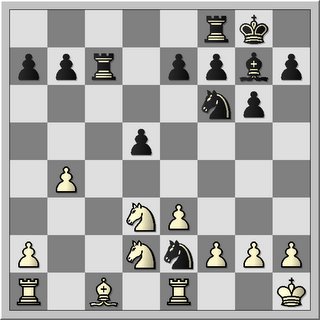With a little help of ...
[,scully]
SCULLY
Why misplaying the opening can be sometimes quite painful?
1.d4 Nf6 2.Nf3 c5!?
I always play c5 as second move against 1.d4-openings. Most of the time it is for 1500 players an out of their book move. Actually Black is inviting White to take the pawn. I never follow up with Qa5+ and capturing of the pawn coz your queen is exposed and much too early in the game. Just develop Nc6,etc and break the center open. The problem with d4 players is that they hate open games. So why not send them immediately an invitation for an open game.
3.c3 cxd4 4.cxd4 d5 5.e3 Bf5
Playing c3 rang a bell. He was playing a system - colle like. That meant as black that I will try to kill his light squared bishop as soon as possible. But first I will try to take control over b1-h7. Controlling this diagonal weakens my Q-side light squares as the bishop is now located to the K-side of the board. So that's why I am not following up with e6 coz in this way my bishop has still access to the Q side through d7. Actually killing his vital light squared bishop, one of the main pieces usable in an attack, is in itself already a victory.

Watch his Q-side pieces.
6.Nbd2 g6 7.Qb3 Qc7 8.Ne5
So why can I play Bg7? Is d5 vulnerable? No If white plays 9. Bb5 black just follows up with 9 ... Nbd7.
So if white wants to exchange on d7 black will take back with light-squared bishop as Knight f6 is necessary to defend d5. And if he continues to trade down black will take back with Q. d5, b7 are now covered by the Queen.
The idea Nbd2 Qb3 is bad development.Locks your dark squared bishop to its initial place and with this the mobility of the rook a1 becomes very much hampered (no rook connection; there is no idea of pushing the e4 pawn (no rook on e1 etc) Considering Qb3 Ne5 Bb5 is not enough pressure on black's defense. Black can hold on. Later during the game white will try to free his dark-squared bishop but it is too late. Black has finished his development and is ready to attack.
8. .. Bg7 9.Bd3 Bxd3 10.Nxd3 0-0 11.0-0 Nc6 12.Qc2? Rac8 13.b4 Nxd4 14.Qxc7 Ne2+ 15.Kh1 Rxc7 16.Re1
Instead white played Bd3, an invitation to trade down one of his most dangerous pieces. Who can resist? After the trade down white wants to free his bishop, therefor moves his Queen to the c-file (not the best). With rook Rac8 I grasped firm control over the c-file. By playing b4 (his idea of freeing the bishop) he actually blunders a pawn. He must have missed the check.
White just played 16. Re1 attacking the knight? How to follow up?
there is the possibility to move the knight, to exchange the knight and to look for a greater threat.
Ne4!! 17.Rb1 Nxc1 18.Rbxc1 Rxc1 19.Nxe4 Rxe1+ 20.Nxe1 dxe4 0-1
Vision without action is daydreaming, action without vision is a nightmare.
Whole game
1.d4 Nf6 2.Nf3 c5 3.c3 cxd4 4.cxd4 d5 5.e3 Bf5 6.Nbd2 g6 7.Qb3 Qc7 8.Ne5 Bg7 9.Bd3 [9.Bb5+ Nbd7] 9...Bxd3 10.Nxd3 0-0 11.0-0 Nc6 12.Qc2 Rac8 13.b4 Nxd4 14.Qxc7 Ne2+ 15.Kh1 Rxc7 16.Re1 Ne4! 17.Rb1
[B)17.Bb2 Bxb2 18.Nxb2 (18.Rab1 Bc3 19.Rxe2 Nxd2 20.Rc1 Rfc8 21.Rc2 Bxb4 22.Nxb4 Rxc2 23.Nxc2 Rxc2) 18...Nxf2#;
C)17.Rxe2 Bxa1 18.Nxe4 dxe4 19.Nc5 b6 20.Nb3 Rd8 21.h3 Rd1+ 22.Kh2 Be5+ 23.g3 Rcxc1 24.Nxc1 Rxc1 -/+
D)17.Nxe4 dxe4 18.Rxe2 exd3 19.Rb2 Rfc8 20.Bd2 Bxb2 21.Rb1 Rc1+ 22.Bxc1 Rxc1+ 23.Rxc1 Bxc1 24.Kg1 d2 25.Kf1 d1Q#]
A)17...Nxc1 18.Rbxc1 [18.Nxc1 Nxd2 19.Nb3 Nxb1-+ 20.Rxb1-+]18...Rxc1 19.Nxe4 Rxe1+ 20.Nxe1 dxe4 0-1


2 Comments:
Great annotation! Hey is your quote inspired by Kant's comments about intuition/understanding? "[T]houghts without content are empty, intuitions without concepts are blind" [CoPR 2; B75].
No, I picked it up at work, someone's footnote within its e-mail. I liked it because there is much truth in it. ( it might be a chinese proverb)
Post a Comment
<< Home